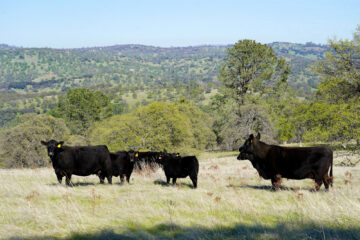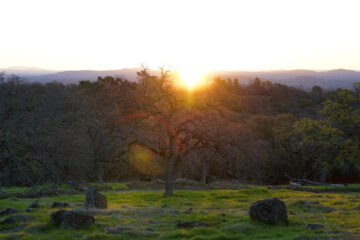Quick Facts:
- 427 acres
- Working, historic cattle ranch owned and operated by Oest Family
- Located along Highway 49 north of Auburn
- Protected by Agricultural Conservation Easements between 2015 and 2018
- Grassland/ rangeland and blue oak woodland habitat, Orr Creek
- Funding partners: California Climate Investments (CA Dept of Conservation SALC Program), CA Wildlife Conservation Board, Placer County, Oest Family, Placer Land Trust
Protecting Working Family Lands
Placer Land Trust worked with Daryl and Sue Oest to protect the 427-acre Lone Star Preserve in three phases from 2015-2018. These projects mark the 3rd, 4th, and 5th/final phase of protecting the entire 940-acre Oest Ranch in Placer County. The Lone Star Preserve is the northern portion of the Oest Ranch, located along Hwy 49 and Lone Star Road close to the Bear River. The other two portions of the Oest Ranch are Lake Clementine Preserve, and Cold Springs Preserve, located east of I-80 near Lake Clementine. All three preserves contain beautiful oak woodlands and pasture.
Family Heritage
Placer Land Trust is proud of our long-standing partnership with the Oest family to permanently protect their ranch for livestock grazing, beekeeping, and other ag uses. The Oests are a pioneering Placer County family that has been farming and ranching in the Auburn area for four generations, since 1859. Placer Land Trust staff joined in honoring the Oest family as they were inducted into the California Agricultural Heritage Club for more than 150 years of farm and ranch productivity.
Local, Sustainable Agriculture
The Oest Ranch is a commercial beef ranch and an important contributor to the local agricultural economy in Placer County. The Agricultural Conservation Easements protect the land from subdivision, development and related uses, but allows for and encourages continued, sustainable agricultural uses. The property remains privately owned and managed by the Oest family. The Oests use best practices to operate their ranch sustainably, including rotational grazing of pastures, an appropriate number of animals per acre, no synthetic fertilizers, and protecting oak woodlands and wetlands.
Public Benefits
While this is a privately-owned ranch and not open to the public, protection of this land from development provides multiple public benefits in other ways.
Supporting Placer County’s agricultural economy – agricultural land in California, and Placer County in particular, is disappearing at a rapid rate. Without options for protection, like Agricultural Conservation Easements, many farmers and ranchers sell their high-priced land for development. Maintaining productive ag land in Placer County benefits the economy by producing food and fiber products (in this case, beef and honey) and through patronage of related businesses (farm supply stores, veterinarians, distributors, etc).
Protecting scenery along Highway 49 and rural roads– Highway 49 is an eligible State Scenic Highway, and the land along it north of Auburn is quickly developing. Oest Ranch is the first significant open space seen by drivers traveling north from Auburn along Highway 49. Protecting natural areas like oak woodlands and ranchlands is key to preserving the scenic beauty and rural lands of the County, and a reason why many people enjoy living here. This is a benefit you can definitely “see” while driving!
Protecting wildlife habitat – The oak woodlands of Oest Ranch support a rich array of plants and wildlife. People can enjoy wildlife watching at nearby Hidden Falls Regional Park or in their own backyards – others simply like knowing it’s there. Protecting wildlife habitat across private land throughout the County is key to migration and survival – it is not enough to protect just public lands. Oest Ranch is part of a large “wildlife corridor” near the Bear River. It’s near the Laursen Bear River Preserve (link), which in turn is next to several other preserves, together creating thousands of acres of protected lands. Much of this is made up of threatened blue oak woodlands that make this area of the Sierra foothills so beautiful, unique and biologically diverse.
Supporting clean water and air – Maintaining the ranch as open space helps keep waterways cleaner than they would be if this land was developed. Oak woodlands, wetlands, and grasslands soak up and store water more than if the area was paved and developed, and supports water supplies downstream. The oak trees and grasslands also absorb and store carbon which helps keep the air cleaner. Management of land through livestock grazing also reduces fuel loads and helps prevent catastrophic wildfires.
Guided Hikes – Placer Land Trust has offered docent-led (guided) public hikes to parts of Oest Ranch and plans to continue this at Lone Star Preserve in the future.
Funding Partners
Funding for the purchase and long-term stewardship of the easements was generously provided by an array of partners: California Climate Investments (Strategic Growth Council’s Sustainable Agricultural Lands Conservation Program, administered by the CA Dept of Conservation), CA Wildlife Conservation Board (Oak Woodlands Conservation Program), Placer County, Placer Land Trust, and the Oest Family.
Funds for Oest Ranch – Lone Star Preserve were made available through the California Strategic Growth Council’s Sustainable Agricultural Lands Conservation Program (SALC) in collaboration with the Department of Conservation. SALC is part of California Climate Investments, a statewide initiative that puts billions of Cap-and-Trade dollars to work reducing greenhouse gas emissions, strengthening the economy, and improving public health and the environment – particularly in disadvantaged communities.
Oest Ranch – Lone Star Preserve is not open to the public. For a list of our properties that have public trails, visit our Trails page.










0 Comments